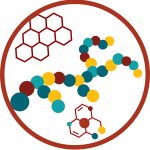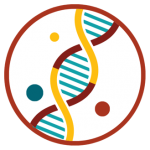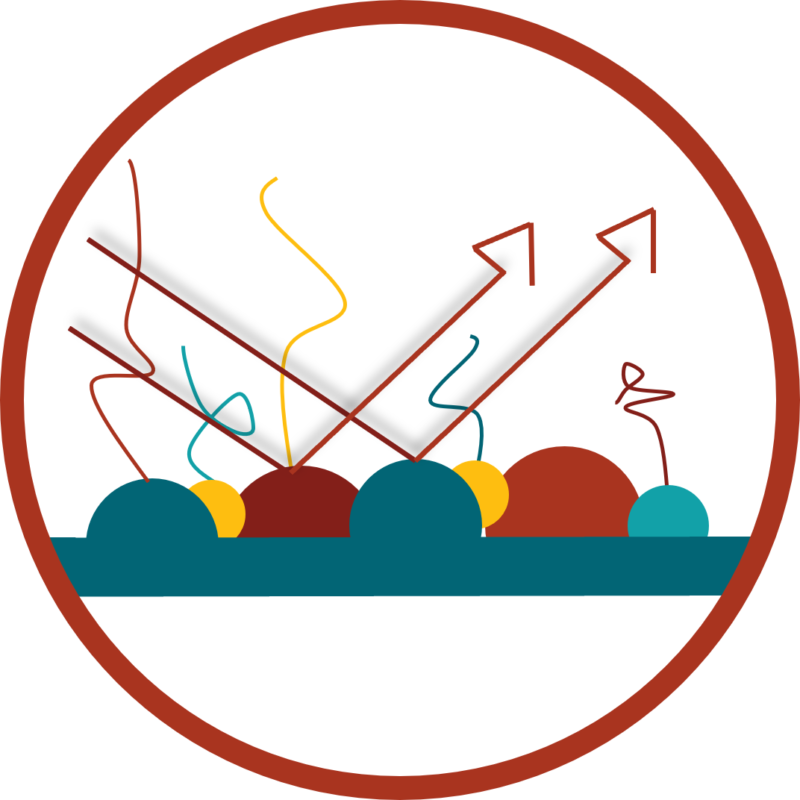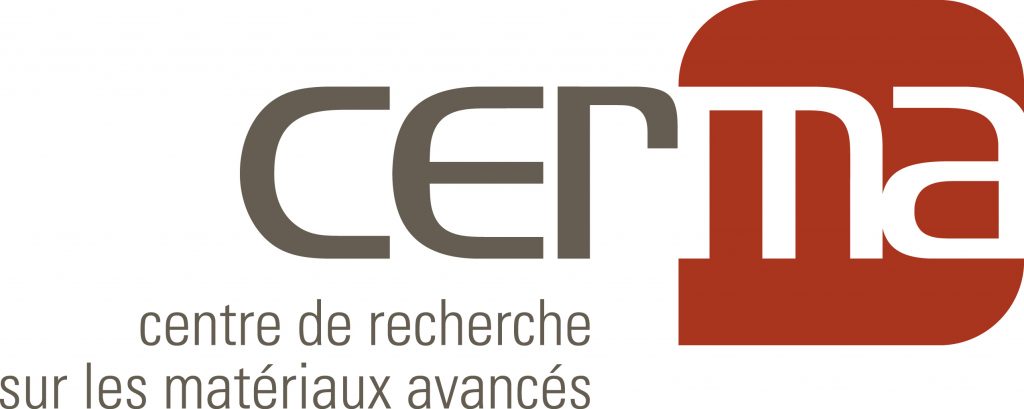Research axis
CERMA covers a wide range of materials: from biological molecules to synthetic molecules, including materials in the solid or viscoelastic state, nanomaterials and hybrid materials. It thus concentrates its activities in the field of “soft” materials, i.e. organic or hybrid materials. The targeted applications range from energy to health, including the wood industry, electro-optics and photonics, 3D printing, and the environment. These various research themes are divided into four main and non-exclusive axes:

Synthetic and natural macromolecules

Nanomaterials
Biopolymers have very interesting properties that researchers are trying to draw inspiration from. Furthermore, by combining different types of monomers, it is possible to obtain very different mechanical, structural and electronic properties of the starting molecules. Coming from natural and synthetic sources, these macromolecules are very interesting and are the subject of exhaustive research within the Center.
This line of research includes the group of Professor Denis Rodrigue whose laboratory specializes in the field of polymers, whether in terms of synthesis, implementation or mechanical properties.
This axis also involves Professor Véronic Landry, whose research focuses on the production of coatings for wood and the introduction of cellulose into various nanocomposites in order to give these materials a more durable and “green” character. We also find in this axis the team of Professor Tatjana Stevanovic Janezic who is interested in the processes of extracting lignin from wood and its use to develop new innovative materials.
Professor Mario Leclerc’s group, for its part, focuses its work on new routes for the synthesis of electroactive and photoactive polymers, in particular direct heteroarylation. This work is supported by the laboratory of Professor Paul Johnson, thanks to a modeling approach making it possible to optimize the synthesis work. Several applications in organic electronics can be imagined, particularly in field effect transistors and solar cells, making these technologies more affordable and less harmful to the environment.
Nanomaterials are at the heart of a revolution in the field of materials. They are increasingly being considered to respond to problems in a multitude of areas. Whether in electronics, medicine or pharmacology, CERMA researchers have great expertise in the study of nanomaterials.
The teams of Professors Anna Ritcey and Marc-André Fortin are working on the synthesis and characterization of hybrid nanoparticles for applications in the field of optics and biophotonics, or in medical imaging as contrast agents or for radiotherapy. These nanoparticles are often luminescent or magnetic with particular spectral signatures. This axis also includes the laboratory of Professor Jean-François Morin, whose work focuses on carbon nanomaterials. Research is focused on the synthesis of conjugated semiconductor materials for organic electronics and the development of organic nano-objects (carbon nanotubes, graphitic nanoparticles, graphene nanoribbons, etc.) in order to modulate their properties.
Professor Élodie Boisselier and her team are working on the development of drug vectors based on gold nanoparticles to increase the effectiveness of ophthalmology treatments. Finally, we also find Professor Mohammad Seyed Taghavi, who uses microfluidics to study the flows of different materials and to generate nanofibers.

Biomaterials

Surfaces and interfaces
This line of research focuses on the study, development and use of artificial and natural materials in biological and medical applications.
It notably involves professors Gaétan Laroche and Diego Mantovani, whose work consists of developing new biocompatible materials by treating their surfaces. The engineering of biodegradable materials, orthopedic prostheses and artificial tissues and organs are also part of their research interests.
Professor Hendra Hermawan is also part of this area with his research on the development of new bioactive and biodegradable metals and on the control of corrosion. Professor Jesse Greener, meanwhile, focuses on the detection and characterization of biofilms using microfluidics techniques. Microfluidics is also used by Professor Amine Miled as part of his projects on the design of biomicrosystems, biosensors, implantable and biomedical devices.
The work of Professor Nicolas Bertrand’s team focuses on the development of new biomaterials and the study of their interactions with their environment in order to increase the effectiveness and safety of active pharmaceutical compounds. The laboratory of Professor Roxane Pouliot uses tissue engineering to develop psoriatic skin substitutes to better understand the pathology and facilitate the discovery of new treatments.
In the forestry sector, Professor Blanchet’s team is developing advanced wood-based products for the eco-construction sector. The general goal is to develop eco-responsible solutions that use wood to reduce the ecological footprint of buildings based on a multidisciplinary and integrated approach that works across the entire value creation network of the construction sector.
Similarly, Marie-Josée Dumont’s group seeks to use Canadian agricultural residual biomass as well as food residues as raw materials for the synthesis of polymers and specialty chemicals. The team works to convert agricultural raw materials into bio-based materials and chemicals, which mimic or have enhanced properties compared to their petroleum-based counterparts.
Developments in materials science require the study of surfaces or interactions at the interface between systems. Several applications are critical depending on the response of surfaces or behavior at interfaces. They may then require surface treatments to improve the properties of the materials.
These phenomena are crucial for biomaterials. The work of Professor Gaétan Laroche’s group focuses on how to ensure the adequate implantation of synthetic prostheses. Plasma treatment is one of the preferred avenues. Likewise, the work of Professor Diego Mantovani’s team aims to optimize (functionalize) the properties of metals for biomedical applications, in particular through the grafting of particular molecules (PEG, antimicrobial peptides) or the use of thin films of polymers.
In the field of tissue regeneration, the work of Professor Roxane Pouliot’s group aims to develop and characterize a new model of skin substitutes to reduce the negative impacts of psoriasis. In order to improve the surface properties of wood, the work carried out in the laboratory of Professor Véronic Landry aims to increase the performance of interior and exterior finishing products. This involves developing wood surface treatments, finishing products, impregnation products, and characterizing their effects.
Another aspect of this axis concerns the study of physicochemical phenomena taking place at interfaces. In order to optimize the development of vectors based on gold nanoparticles for ophthalmology medication, the laboratory of Professor Élodie Boisselier is studying the interactions of molecules at the phospholipid-water interface of membrane systems. For applications in bioenergy and microfluidics, the group of Professor Jesse Greener, with the help of Professor Amine Miled, devotes part of its studies to the development of bacterial biofilms. This work particularly highlights interactions with surfaces. In optics and photonics, Professor Anna Ritcey’s team focuses on the self-assembly at interfaces and of micellar systems with plasmonic properties. The work leverages block copolymers to direct the organization of periodic and ordered nanometric structures, such as micelles and nano-rings.

Synthetic and natural macromolecules
Biopolymers have very interesting properties that researchers are trying to draw inspiration from. Furthermore, by combining different types of monomers, it is possible to obtain very different mechanical, structural and electronic properties of the starting molecules. Coming from natural and synthetic sources, these macromolecules are very interesting and are the subject of exhaustive research within the Center.
This line of research includes the group of Professor Denis Rodrigue whose laboratory specializes in the field of polymers, whether in terms of synthesis, implementation or mechanical properties.
This axis also involves Professor Véronic Landry, whose research focuses on the production of coatings for wood and the introduction of cellulose into various nanocomposites in order to give these materials a more durable and “green” character. We also find in this axis the team of Professor Tatjana Stevanovic Janezic who is interested in the processes of extracting lignin from wood and its use to develop new innovative materials.
Professor Mario Leclerc’s group, for its part, focuses its work on new routes for the synthesis of electroactive and photoactive polymers, in particular direct heteroarylation. This work is supported by the laboratory of Professor Paul Johnson, thanks to a modeling approach making it possible to optimize the synthesis work. Several applications in organic electronics can be imagined, particularly in field effect transistors and solar cells, making these technologies more affordable and less harmful to the environment.

Nanomaterials
Nanomaterials are at the heart of a revolution in the field of materials. They are increasingly being considered to respond to problems in a multitude of areas. Whether in electronics, medicine or pharmacology, CERMA researchers have great expertise in the study of nanomaterials.
The teams of Professors Anna Ritcey and Marc-André Fortin are working on the synthesis and characterization of hybrid nanoparticles for applications in the field of optics and biophotonics, or in medical imaging as contrast agents or for radiotherapy. These nanoparticles are often luminescent or magnetic with particular spectral signatures. This axis also includes the laboratory of Professor Jean-François Morin, whose work focuses on carbon nanomaterials. Research is focused on the synthesis of conjugated semiconductor materials for organic electronics and the development of organic nano-objects (carbon nanotubes, graphitic nanoparticles, graphene nanoribbons, etc.) in order to modulate their properties.
Professor Élodie Boisselier and her team are working on the development of drug vectors based on gold nanoparticles to increase the effectiveness of ophthalmology treatments. Finally, we also find Professor Mohammad Seyed Taghavi, who uses microfluidics to study the flows of different materials and to generate nanofibers.

Biomaterials
This line of research focuses on the study, development and use of artificial and natural materials in biological and medical applications.
It notably involves professors Gaétan Laroche and Diego Mantovani, whose work consists of developing new biocompatible materials by treating their surfaces. The engineering of biodegradable materials, orthopedic prostheses and artificial tissues and organs are also part of their research interests.
Professor Hendra Hermawan is also part of this area with his research on the development of new bioactive and biodegradable metals and on the control of corrosion. Professor Jesse Greener, meanwhile, focuses on the detection and characterization of biofilms using microfluidics techniques. Microfluidics is also used by Professor Amine Miled as part of his projects on the design of biomicrosystems, biosensors, implantable and biomedical devices.
The work of Professor Nicolas Bertrand’s team focuses on the development of new biomaterials and the study of their interactions with their environment in order to increase the effectiveness and safety of active pharmaceutical compounds. The laboratory of Professor Roxane Pouliot uses tissue engineering to develop psoriatic skin substitutes to better understand the pathology and facilitate the discovery of new treatments.
In the forestry sector, Professor Blanchet’s team is developing advanced wood-based products for the eco-construction sector. The general goal is to develop eco-responsible solutions that use wood to reduce the ecological footprint of buildings based on a multidisciplinary and integrated approach that works across the entire value creation network of the construction sector.
Similarly, Marie-Josée Dumont’s group seeks to use Canadian agricultural residual biomass as well as food residues as raw materials for the synthesis of polymers and specialty chemicals. The team works to convert agricultural raw materials into bio-based materials and chemicals, which mimic or have enhanced properties compared to their petroleum-based counterparts.

Surfaces and interfaces
Developments in materials science require the study of surfaces or interactions at the interface between systems. Several applications are critical depending on the response of surfaces or behavior at interfaces. They may then require surface treatments to improve the properties of the materials.
These phenomena are crucial for biomaterials. The work of Professor Gaétan Laroche’s group focuses on how to ensure the adequate implantation of synthetic prostheses. Plasma treatment is one of the preferred avenues. Likewise, the work of Professor Diego Mantovani’s team aims to optimize (functionalize) the properties of metals for biomedical applications, in particular through the grafting of particular molecules (PEG, antimicrobial peptides) or the use of thin films of polymers.
In the field of tissue regeneration, the work of Professor Roxane Pouliot’s group aims to develop and characterize a new model of skin substitutes to reduce the negative impacts of psoriasis. In order to improve the surface properties of wood, the work carried out in the laboratory of Professor Véronic Landry aims to increase the performance of interior and exterior finishing products. This involves developing wood surface treatments, finishing products, impregnation products, and characterizing their effects.
Another aspect of this axis concerns the study of physicochemical phenomena taking place at interfaces. In order to optimize the development of vectors based on gold nanoparticles for ophthalmology medication, the laboratory of Professor Élodie Boisselier is studying the interactions of molecules at the phospholipid-water interface of membrane systems. For applications in bioenergy and microfluidics, the group of Professor Jesse Greener, with the help of Professor Amine Miled, devotes part of its studies to the development of bacterial biofilms. This work particularly highlights interactions with surfaces. In optics and photonics, Professor Anna Ritcey’s team focuses on the self-assembly at interfaces and of micellar systems with plasmonic properties. The work leverages block copolymers to direct the organization of periodic and ordered nanometric structures, such as micelles and nano-rings.


